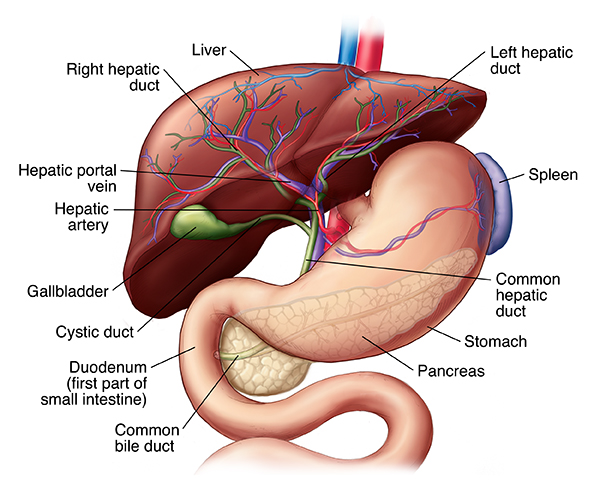How the Liver Works
The liver is located in the upper right part of your belly (abdomen). Most of it is protected by your ribs. It's a vital organ that has many jobs. The liver:
-
Makes bile, a substance that helps your body absorb fat
-
Makes proteins and blood-clotting factors that your body needs
-
Controls sugar (glucose) in the blood and stores extra sugar
-
Works with your stomach and intestines to digest food
-
Controls production and removal of cholesterol
-
Stores vitamins and minerals
-
Removes poisonous (toxic) substances from your blood, as well as many prescription and over-the-counter medicines
-
Regulates other organs, such as the kidneys
-
Is part of the immune system, which helps your body fight infection
The parts of the liver and nearby organs
-
Biliary tree. A network of tubes that carry bile out of the liver and into the gallbladder and the first part of the small intestine (duodenum).
-
Bile ducts. Tubes between the liver and small intestine. Bile drains into them from the liver.
-
Common bile duct. The duct from the liver (hepatic duct) and the duct from the gallbladder (cystic duct) meet to form the common bile duct. The common bile duct carries bile to the duodenum.
-
Duodenum. The first part of the small intestine. When bile leaves the liver, it flows through the bile ducts into the duodenum. Here, bile starts mixing with food to help digest fat.
-
Gallbladder. The organ that stores bile.
-
Spleen. An organ that filters blood. It also helps keep your body healthy and free of infection as part of the immune system.
-
Splenic vein. A blood vessel that carries blood from the spleen to the portal vein.
-
Hepatic portal vein. A blood vessel that carries blood containing nutrients and oxygen from the digestive tract and spleen into the liver.
-
Inferior vena cava. A large vein that carries blood from the liver, intestines, legs, and kidneys to the heart.
-
Hepatic veins. Blood vessels that carry blood out of the liver to the inferior vena cava.
-
Hepatic artery. A blood vessel that carries blood with a fresh supply of oxygen into the liver from the heart.

Blood flows through the liver
All the blood that flows from the intestines, stomach, and spleen is filtered through the liver. The blood flows into the liver through the hepatic portal vein. It filters through the liver in a system of smaller and smaller veins. As blood passes over liver cells, these cells process nutrients in the blood. This processing makes products like proteins and sugars that your body can use. Blood is carried out of the liver through the hepatic veins to the heart.
© 2000-2024 The StayWell Company, LLC. All rights reserved. This information is not intended as a substitute for professional medical care. Always follow your healthcare professional's instructions.